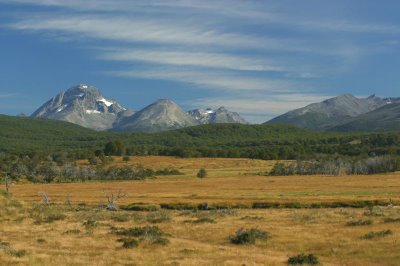 This image from the High Resolution Imaging Science Experiment on NASA's Mars Reconnaissance Orbiter shows the Mars Exploration Rover Opportunity near the rim of "Victoria Crater." High Res (large format) Photo Link. Image Credit: NASA/JPL/UA - Reconnaissance Orbiter
This image from the High Resolution Imaging Science Experiment on NASA's Mars Reconnaissance Orbiter shows the Mars Exploration Rover Opportunity near the rim of "Victoria Crater." High Res (large format) Photo Link. Image Credit: NASA/JPL/UA - Reconnaissance OrbiterRobot Photojournalism: Space Rover Photographs Land Rover
The fruits of our public monies should be more available and broadcast with greater saturation. These images can be found at the NASA website but the "Fourth Estate" is doing our society a dis-service by not broadcasting these images on a regular basis.
 From an altitude of 170 miles, the orbiter could see the Opportunity rover from above. In the inset, the small line extending to the lower right from the rover is the shadow of the mast on which the rover's cameras are mounted. Image Credit: NASA
From an altitude of 170 miles, the orbiter could see the Opportunity rover from above. In the inset, the small line extending to the lower right from the rover is the shadow of the mast on which the rover's cameras are mounted. Image Credit: NASAThis from NASA -
Victoria is an impact crater about 800 meters (half a mile) in diameter at Meridiani Planum near the equator of Mars. Opportunity has been operating on Mars since January, 2004. Five days before this image was taken, Opportunity arrived at the rim of Victoria, after a drive of more than 9 kilometers (over 5 miles). It then drove to the position where it is seen in this image.
Shown in the image are "Duck Bay," the eroded segment of the crater rim where Opportunity first arrived at the crater; "Cabo Frio," a sharp promontory to the south of Duck Bay; and "Cape Verde," another promontory to the north. When viewed at the highest resolution, this image shows the rover itself, wheel tracks in the soil behind it, and the rover's shadow, including the shadow of the camera mast. After this image was taken, Opportunity moved to the very tip of Cape Verde to perform more imaging of the interior of the crater.
This view is a portion of an image taken by the High Resolution Imaging Science Experiment (HiRISE) camera onboard the Mars Reconnaissance Orbiter spacecraft on Oct. 3, 2006. The complete image is centered at minus7.8 degrees latitude, 279.5 degrees East longitude. The range to the target site was 297 kilometers (185.6 miles). At this distance the image scale is 29.7 centimeters (12 inches) per pixel (with 1 x 1 binning) so objects about 89 centimeters (35 inches) across are resolved. North is up. The image was taken at a local Mars time of 3:30 PM and the scene is illuminated from the west with a solar incidence angle of 59.7 degrees, thus the sun was about 30.3 degrees above the horizon. At a solar longitude of 113.6 degrees, the season on Mars is northern summer.
Images from the High Resolution Imaging Science Experiment and additional information about the Mars Reconnaissance Orbiter are available online at: http://www.nasa.gov/mission_pages/MRO/main/index.html or http://hirise.lpl.arizona.edu/.
Reference Here>>
 Layers of 'Cabo Frio' in 'Victoria Crater' - This view of "Victoria crater" is looking southeast from "Duck Bay" towards the dramatic promontory called "Cabo Frio." The small crater in the right foreground, informally known as "Sputnik", is about 20 meters (about 65 feet) away from the rover, the tip of the spectacular, layered, Cabo Frio promontory itself is about 200 meters (about 650 feet) away from the rover, and the exposed rock layers are about 15 meters (about 50 feet) tall. This is an approximately true color rendering of images taken by the panoramic camera (Pancam) on NASA's Mars Exploration Rover Opportunity during the rover's 952nd sol, or Martian day, (Sept. 28, 2006) using the camera's 750-nanometer, 530-nanometer and 430-nanometer filters. Image Credit: NASA/JPL/Cornell
Layers of 'Cabo Frio' in 'Victoria Crater' - This view of "Victoria crater" is looking southeast from "Duck Bay" towards the dramatic promontory called "Cabo Frio." The small crater in the right foreground, informally known as "Sputnik", is about 20 meters (about 65 feet) away from the rover, the tip of the spectacular, layered, Cabo Frio promontory itself is about 200 meters (about 650 feet) away from the rover, and the exposed rock layers are about 15 meters (about 50 feet) tall. This is an approximately true color rendering of images taken by the panoramic camera (Pancam) on NASA's Mars Exploration Rover Opportunity during the rover's 952nd sol, or Martian day, (Sept. 28, 2006) using the camera's 750-nanometer, 530-nanometer and 430-nanometer filters. Image Credit: NASA/JPL/CornellThis from ABC News –
Earthlings Invade Mars
U.S. Probes Send New Images of Martian Surface
By NED POTTER
Oct. 6, 2006 — "NASA is in the process of taking over Mars," said Steven Squyres, the principal investigator for the two rovers Spirit and Opportunity, which have been exploring the Martian surface for more than two years.
"Today is day 960 of Opportunity's 90-day mission," he said today at a Washington news conference. The rovers have gone far beyond their expected lifetimes, and NASA has had to come up with money to keep funding its support team on Earth.
Now the rovers have been joined by a new ship, the Mars Reconnaissance Orbiter, which is circling the planet at an altitude of 170 miles and sending back its first images. They are so detailed that in one, the Opportunity rover appears as a small, dark triangle, perched on the edge of a crater.
A dark line extends from the triangle. Scientists said it is the shadow of the mast on Opportunity's top deck that carries most of its cameras.
 This part of Victoria crater has been nicknamed Cape Verde. Scientists would like to sample it closely, but after more than two years in the Martian cold, the rover is showing signs of wear. "We are not going to do a leisurely tour of this crater," said Steve Squyres, the principal investigator, "because our days are numbered." Image Credit: NASA
This part of Victoria crater has been nicknamed Cape Verde. Scientists would like to sample it closely, but after more than two years in the Martian cold, the rover is showing signs of wear. "We are not going to do a leisurely tour of this crater," said Steve Squyres, the principal investigator, "because our days are numbered." Image Credit: NASASandy Desert in the Martian Cold
Opportunity has been exploring a vast, sandy plain on Mars, and its operators back on Earth say they're amazed it's still operating. It's gotten stuck in the sand twice; one time they had to spin the wheels for six weeks to get it free.
There is no way to tow it free. Mars is currently about 240 million miles from Earth.
The crater at which Opportunity has now arrived is called Victoria. It is about a mile wide, and Squyres said it offers a great chance to see beneath the upper layers of soil.
"What an amazing time for space exploration," said Jim Bell, Squyres' long-time partner on the rover project. Bell and Squyres, both scientists at Cornell University, first proposed the Mars rovers in 1987.
Opportunity will now probe the cliffs that surround Victoria crater. But after 960 days on Mars, it is showing signs of wear. One of its wheels won't turn, and its batteries are harder to charge.
"We are not going to do a leisurely tour of this crater, because our days are numbered," Squyres said.
Please take a look at the newest pictures HERE.
Reference Link>>
 NASA's Mars Exploration Rover Opportunity reached the rim of "Victoria Crater" on Sept. 27, 2006, during the 951st Martian day, or sol, of the rover's work in the Meridian Planum region of Mars. Opportunity drove 9.28 kilometers (5.77 miles) in the explorations that took it from "Eagle Crater," where it landed in January 2004, eastward to "Endurance Crater," which it investigated for about half of 2004, then southward to Victoria.
NASA's Mars Exploration Rover Opportunity reached the rim of "Victoria Crater" on Sept. 27, 2006, during the 951st Martian day, or sol, of the rover's work in the Meridian Planum region of Mars. Opportunity drove 9.28 kilometers (5.77 miles) in the explorations that took it from "Eagle Crater," where it landed in January 2004, eastward to "Endurance Crater," which it investigated for about half of 2004, then southward to Victoria.This map of Opportunity's trek so far is overlaid onto images taken by the Mars Orbiter Camera on NASA's Mars Global Surveyor. Victoria is about 800 meters (one-half mile) in diameter, or about five times wider than Endurance and 40 times wider than Eagle. The scale bar at lower right shows the length of 800 meters (0.50 mile). North is up.
The following gives the Earth date for the sol number on the image at right: Sol 58 was Mar. 24, 2004 Sol 315 was Dec. 12, 2004. Sol 446 was Apr. 26, 2005 Sol 654 was Nov. 25, 2005 Sol 833 was May 28, 2006 Sol 898 was Aug. 3, 2006 Sol 952 was Sept. 28, 2006 + High resolution version Image Credit: NASA/JPL/MSSS/Ohio State University





























